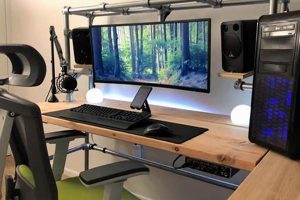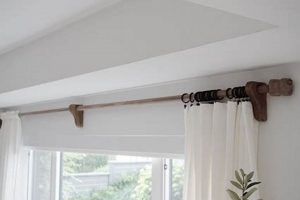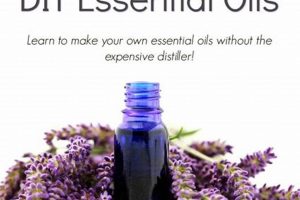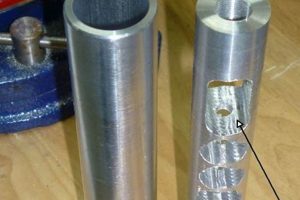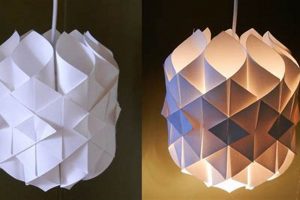The creation of a cleaning solution for whiteboards using readily available household items represents a cost-effective and environmentally conscious approach to maintaining these surfaces. Such solutions are typically formulated with ingredients like isopropyl alcohol, vinegar, or baking soda, often diluted with water to achieve the desired cleaning efficacy. A practical illustration involves mixing equal parts of isopropyl alcohol and water in a spray bottle, which is then applied to the whiteboard and wiped clean with a microfiber cloth.
Employing homemade alternatives offers several advantages. It reduces reliance on commercially produced whiteboard cleaners, often packaged in single-use plastic containers, thereby minimizing environmental impact. Furthermore, it allows for control over the ingredients used, avoiding potentially harsh chemicals that might degrade the whiteboard surface over time. Historically, simple cleaning solutions have been favored due to their accessibility and effectiveness, pre-dating the widespread availability of specialized products.
The subsequent sections will detail specific formulations, application techniques, and preventative measures to optimize the longevity and performance of whiteboards through the application of these user-created cleaning methods. This includes exploring various ingredient combinations, addressing persistent stain removal, and outlining best practices for regular maintenance.
DIY Whiteboard Cleaning
Effective whiteboard maintenance hinges on consistent cleaning practices. Implementing the following guidelines can extend whiteboard lifespan and maintain optimal erasability.
Tip 1: Immediate Erasing. Erase whiteboard markings immediately after use. Ink left on the surface for extended periods tends to dry and bond, making it more difficult to remove and potentially causing ghosting.
Tip 2: Microfiber Cloth Application. Utilize microfiber cloths for cleaning. These cloths are non-abrasive and effectively lift ink particles without scratching the whiteboard surface. Avoid using paper towels, which can leave residue and cause damage.
Tip 3: Isopropyl Alcohol Dilution. When employing isopropyl alcohol, dilute it with water. A concentration of 70% isopropyl alcohol to 30% water is typically sufficient. This prevents the alcohol from drying too quickly and damaging the board’s surface.
Tip 4: Vinegar Solution Application. White vinegar can be used for cleaning. Mix equal parts white vinegar and water in a spray bottle. This solution is effective for removing grease and stubborn stains. Ensure the surface is thoroughly dried after application.
Tip 5: Baking Soda Paste for Stubborn Marks. For persistent stains, create a paste of baking soda and water. Gently apply the paste to the affected area, let it sit for a few minutes, and then wipe it clean with a damp cloth. Rinse the area thoroughly to remove any baking soda residue.
Tip 6: Regular Cleaning Schedule. Establish a regular cleaning schedule. Daily wiping with a dry microfiber cloth and weekly cleaning with a cleaning solution can prevent ink buildup and maintain whiteboard clarity.
Tip 7: Marker Quality Considerations. Utilize high-quality whiteboard markers specifically designed for use on dry-erase surfaces. Inferior markers can leave behind residue that is difficult to remove.
Consistent and proper application of these techniques ensures effective whiteboard maintenance, reduces the need for harsh chemicals, and prolongs the board’s usability.
The subsequent sections will delve into specific troubleshooting scenarios and explore advanced cleaning techniques for particularly challenging whiteboard conditions.
1. Ingredient Selection
Ingredient selection is paramount in the formulation of any effective cleaning agent, including a solution created for whiteboard maintenance. The choice of components directly influences the cleaning power, potential for surface damage, and overall safety of the solution.
- Solvent Selection
The primary solvent in a homemade whiteboard cleaner is crucial for dissolving ink residue. Isopropyl alcohol is a common choice due to its solvency and rapid evaporation. However, the concentration must be carefully considered. High concentrations can damage the whiteboard surface over time, leading to cracking or discoloration. Alternatives, like distilled white vinegar, offer a gentler approach but may require more effort for stain removal.
- Surfactant Considerations
Surfactants reduce the surface tension of the solution, allowing it to spread more effectively and lift dirt from the whiteboard surface. A mild dish soap, used sparingly, can act as a surfactant. However, excessive use can leave a residue that is difficult to remove, resulting in streaks. The type and amount of surfactant must be carefully balanced to achieve effective cleaning without detrimental side effects.
- Water Quality Impact
The quality of water used in the solution also plays a significant role. Hard water, containing high mineral content, can leave deposits on the whiteboard surface, creating streaks and reducing erasability. Distilled or deionized water is preferable, as it is free from minerals and contaminants that can interfere with the cleaning process.
- Abrasive Exclusion
Abrasive ingredients, such as powdered cleansers or scouring agents, must be strictly avoided. These substances can scratch and damage the whiteboard surface, rendering it unusable. The goal is to dissolve and lift ink residue, not to physically scrub it away. Therefore, the selection of non-abrasive components is critical for preserving the integrity of the whiteboard.
In summary, the careful selection of ingredients for a homemade whiteboard cleaning solution requires a thorough understanding of their individual properties and potential interactions. By prioritizing effective solvency, gentle surfactants, high-quality water, and the exclusion of abrasives, it is possible to create a cleaning agent that is both effective and safe for whiteboard maintenance.
2. Dilution Ratios
The effectiveness and safety of a homemade whiteboard cleaner are fundamentally linked to the precision of dilution ratios employed. Incorrect proportions of cleaning agents and water can lead to suboptimal cleaning performance or, conversely, damage to the whiteboard surface.
- Solvent Concentration Effects
The concentration of the solvent, typically isopropyl alcohol or vinegar, directly influences its ability to dissolve ink residue. An insufficient solvent concentration results in incomplete removal of markings, necessitating repeated cleaning attempts. Conversely, an excessively high concentration of alcohol can degrade the whiteboard surfa
ce, causing dryness, cracking, or discoloration. A balanced ratio is therefore essential for optimal cleaning while minimizing the risk of damage. For instance, a 70% isopropyl alcohol solution is commonly recommended, as it strikes a balance between cleaning power and material compatibility. - Surfactant Dilution Implications
When incorporating a surfactant, such as mild dish soap, the dilution ratio is critical for preventing residue buildup. Excessive surfactant can leave a film on the whiteboard surface, leading to streaks and reduced erasability. A small amount of surfactant, typically a few drops per cup of solution, is sufficient to reduce surface tension and enhance cleaning efficacy. Over-dilution, on the other hand, may compromise the cleaning action, requiring more aggressive scrubbing or additional cleaning cycles.
- Water-to-Agent Balance
The water component in a homemade whiteboard cleaner serves as a carrier for the active cleaning agents and helps to rinse away dissolved ink and dirt. The ratio of water to the cleaning agent must be carefully considered. Too little water can result in a concentrated solution that is harsh on the whiteboard surface. Too much water can dilute the cleaning agent to the point where it is ineffective. The optimal balance ensures thorough cleaning without leaving behind excessive moisture or residue. Distilled water is generally preferred, as it lacks minerals that can leave streaks.
- pH Level Adjustment
The pH level of the final solution can also impact cleaning performance and board integrity. High alkalinity or acidity can damage certain whiteboard surfaces. While ingredients like vinegar are acidic, the dilution with water helps to moderate the pH. It is advisable to avoid highly acidic or alkaline substances in homemade whiteboard cleaner formulations to prevent potential harm. Maintaining a near-neutral pH is conducive to safe and effective cleaning.
In conclusion, the strategic determination of dilution ratios is a critical factor in the preparation of a successful DIY whiteboard cleaner. By carefully calibrating the proportions of solvent, surfactant, and water, a solution can be created that effectively removes ink residue while safeguarding the long-term integrity of the whiteboard surface. Consistent adherence to recommended ratios contributes to both cleaning efficacy and the longevity of the whiteboard.
3. Application Method
The method of application is a crucial determinant in the efficacy of any cleaning solution, including those prepared for whiteboard maintenance. The technique employed directly affects the thoroughness of cleaning, the potential for surface damage, and the even distribution of the cleaning agent.
- Cloth Material Selection
The material of the cleaning cloth significantly influences the outcome of the cleaning process. Microfiber cloths are generally recommended due to their non-abrasive nature and ability to lift ink particles without leaving residue. Conversely, rough cloths or paper towels can scratch the whiteboard surface, diminishing its erasability over time. The choice of cloth material should prioritize gentleness and effective particle removal.
- Spray vs. Direct Application
The method of applying the cleaning solution, whether through spraying or direct application with a cloth, impacts its distribution and effectiveness. Spraying allows for an even and controlled distribution of the cleaning agent across the whiteboard surface. Direct application, however, can lead to uneven distribution and potential pooling of the solution in certain areas. The choice between these methods depends on the size of the whiteboard and the desired level of control over solution distribution.
- Pressure and Motion Control
The amount of pressure applied during cleaning and the motion used to wipe the surface are critical factors. Excessive pressure can damage the whiteboard’s coating, while insufficient pressure may not effectively remove ink residue. A gentle, circular motion is typically recommended to lift dirt and ink particles without causing abrasion. The application should be consistent and even to ensure uniform cleaning across the entire surface.
- Drying Techniques
Proper drying of the whiteboard surface after cleaning is essential for preventing streaks and water spots. Allowing the solution to air dry can result in uneven drying and the formation of visible streaks. Wiping the surface with a clean, dry microfiber cloth immediately after cleaning ensures even drying and a streak-free finish. This final step is crucial for maintaining the whiteboard’s clarity and erasability.
In summary, the application method is an integral aspect of effective whiteboard cleaning. By considering the material of the cleaning cloth, the method of solution distribution, the pressure and motion applied during cleaning, and the drying techniques employed, the user can maximize the effectiveness of a homemade whiteboard cleaner while minimizing the risk of surface damage. Proper application techniques contribute to the long-term performance and aesthetic appeal of the whiteboard.
4. Surface Compatibility
The interaction between a homemade whiteboard cleaner and the specific material composition of the whiteboard surface dictates the cleaner’s efficacy and potential for causing damage. A comprehensive understanding of surface compatibility is, therefore, paramount when formulating and applying such solutions.
- Material Sensitivity
Whiteboard surfaces are typically constructed from melamine, coated steel, or porcelain-on-steel. Each material exhibits distinct sensitivities to various chemical compounds. Melamine, for instance, is more susceptible to damage from abrasive cleaners and high concentrations of alcohol, potentially leading to surface degradation and reduced erasability. Porcelain-on-steel, conversely, demonstrates greater resistance to chemical exposure but can still be affected by highly acidic or alkaline solutions. Identifying the whiteboard’s material is the first step in ensuring surface compatibility.
- Coating Integrity
The coating applied to the whiteboard surface, designed to facilitate smooth writing and easy erasing, is vulnerable to certain cleaning agents. Solvents like acetone or harsh chemicals found in some commercial cleaners can dissolve or damage the coating, resulting in ghosting (residual marker ink that cannot be fully erased) or permanent staining. A homemade solution must be formulated with consideration for maintaining the integrity of this coating, favoring gentle, pH-neutral ingredients.
- Porous vs. Non-Porous Surfaces
The porosity of the whiteboard surface influences the penetration and retention of cleaning solutions. Porous surfaces, often found in older or lower-quality whiteboards, are more likely to absorb cleaning agents and residual ink, making complete removal difficult. Non-porous surfaces, conversely, offer better resistance to absorption and are easier to clean. The choice of cleaning solution and application method should be adapted to the surface’s porosity, with porous surfaces requiring more frequent but gentler cleaning.
- Long-Term Effects
Repeated ap
plication of incompatible cleaning solutions can lead to cumulative damage to the whiteboard surface over time. Even if immediate damage is not apparent, the gradual degradation of the coating or material can result in reduced erasability, increased susceptibility to staining, and a shortened lifespan. Therefore, a long-term perspective is crucial when selecting and using a homemade whiteboard cleaner, prioritizing solutions known to be safe and gentle for the specific whiteboard material.
The preceding considerations highlight the critical role of surface compatibility in the context of utilizing homemade whiteboard cleaners. A thorough assessment of the whiteboard’s material composition, coating integrity, porosity, and the potential for long-term effects is essential for formulating and applying cleaning solutions that effectively maintain the surface without causing irreversible damage. The careful selection of compatible ingredients and application techniques contributes directly to the longevity and performance of the whiteboard.
5. Residue Removal
In the context of homemade whiteboard cleaning solutions, residue removal constitutes a critical step influencing the surface’s long-term usability and aesthetic appeal. Inadequate residue removal, following the application of a do-it-yourself cleaning agent, can lead to a buildup of cleaning solution components, attracting dust and further contaminants, thereby degrading the erasability of the whiteboard. For instance, if a baking soda paste is used to address stubborn marks and is not thoroughly rinsed, the remaining baking soda particles can create a hazy film that interferes with marker adhesion and removal. Therefore, the effectiveness of any “diy whiteboard cleaner” is intrinsically linked to the method and thoroughness of residue elimination.
The composition of the “diy whiteboard cleaner” significantly impacts the ease of residue removal. Solutions containing excessive amounts of surfactants, such as dish soap, are particularly prone to leaving behind a film that necessitates multiple rinsing steps. Furthermore, the water quality used during the cleaning process affects residue formation. Hard water, with its high mineral content, can deposit mineral residues on the whiteboard surface, exacerbating the problem. A practical example involves using a solution of vinegar and water for cleaning; while vinegar is an effective cleaning agent, if not diluted properly or if hard water is used for dilution, it can leave visible streaks and mineral deposits. This underscores the importance of formulating “diy whiteboard cleaner” solutions that minimize the potential for persistent residue.
Effective residue removal demands careful attention to detail and the use of appropriate tools. Employing clean, lint-free microfiber cloths for rinsing and drying is essential to prevent the introduction of additional particulate matter. Multiple wiping passes with a damp cloth, followed by drying with a dry cloth, are often necessary to ensure complete removal of cleaning agent remnants. In summary, successful “diy whiteboard cleaner” application necessitates not only an effective cleaning solution but also a meticulously executed residue removal process to maintain the whiteboard’s optimal performance and appearance. Failure to address this aspect can negate the benefits of even the most carefully crafted homemade cleaning formulas.
6. Regular Maintenance
Sustained whiteboard performance is inextricably linked to consistent and appropriate maintenance practices. The utilization of a do-it-yourself cleaning solution, while potentially cost-effective and environmentally conscious, necessitates a structured maintenance regimen to prevent the accumulation of ink residue, ensure optimal erasability, and prolong the lifespan of the writing surface.
- Daily Dry Erasing
The immediate erasure of whiteboard markings after each use serves as the cornerstone of preventative maintenance. Ink left undisturbed for extended periods tends to dry and adhere more firmly to the surface, increasing the difficulty of subsequent removal. Consistent daily dry erasing minimizes the likelihood of ghosting and the need for more aggressive cleaning methods, thereby reducing the frequency with which a homemade cleaning solution must be employed.
- Weekly Solution Application
The regular application of a DIY whiteboard cleaner, typically on a weekly basis, is crucial for removing accumulated ink residue and maintaining the surface’s pristine condition. This practice helps to prevent the buildup of substances that can compromise erasability and lead to permanent staining. The specific formulation of the solution should be tailored to the whiteboard’s material composition and the types of markers used, ensuring compatibility and minimizing the risk of damage. Thorough removal of the cleaning solution residue is also paramount to prevent the formation of streaks or films.
- Periodic Deep Cleaning
In addition to routine maintenance, periodic deep cleaning is advisable to address stubborn stains or areas exhibiting reduced erasability. This may involve the use of a slightly more concentrated DIY cleaning solution or the application of specialized techniques, such as a baking soda paste, to lift ingrained ink particles. However, caution must be exercised to avoid abrasive actions that could scratch or damage the whiteboard surface. Deep cleaning should be reserved for instances where routine maintenance proves insufficient and should be followed by thorough rinsing and drying.
- Marker Selection and Rotation
The type of markers used on the whiteboard directly impacts the ease of cleaning and the overall maintenance requirements. High-quality markers designed specifically for use on dry-erase surfaces typically produce less residue and are easier to erase. Regularly rotating markers, or replacing them when they begin to dry out, can also help to prevent the buildup of difficult-to-remove ink. Furthermore, using markers of different colors can sometimes reveal variations in surface texture or coating integrity, allowing for targeted maintenance in specific areas.
These interconnected facets of regular maintenance, when diligently practiced, significantly enhance the effectiveness of any chosen do-it-yourself whiteboard cleaning regimen. A proactive approach, characterized by consistent cleaning, appropriate solution selection, and mindful marker usage, ensures the sustained performance and longevity of the whiteboard surface, minimizing the need for harsh chemicals and maximizing the return on investment.
Frequently Asked Questions
This section addresses common inquiries and concerns regarding the formulation and application of homemade whiteboard cleaning solutions. The aim is to provide clarity and promote informed decision-making when pursuing this cleaning method.
Question 1: Is isopropyl alcohol safe for all whiteboard surfaces?
Isopropyl alcohol, while generally effective at dissolving ink, can potentially damage certain whiteboard surfaces if used in high concentrations or with excessive frequency. It is advisable to dilute isopropyl alcohol with water, typically in a 70% alcohol to 30% water ratio, to mitigate the risk of surface degradation. Furthermore, testing the solution on a small, inconspicuous area of the whiteboard is recommended prior
to widespread application.
Question 2: Can vinegar be used as a substitute for isopropyl alcohol in a homemade whiteboard cleaner?
Yes, distilled white vinegar can serve as an alternative to isopropyl alcohol, particularly for removing grease or stubborn stains. Vinegar possesses mild acidic properties that effectively dissolve residue without the harshness associated with some solvents. However, it is essential to dilute vinegar with water, usually in equal parts, to prevent potential damage to the whiteboard surface. Thorough drying is necessary to avoid residual vinegar odor.
Question 3: Will using dish soap in a “diy whiteboard cleaner” leave a residue?
The inclusion of dish soap as a surfactant can enhance the cleaning power of a homemade whiteboard solution. However, excessive use of dish soap is prone to leaving a residue that reduces erasability and creates streaks. Employing only a few drops of mild dish soap per cup of cleaning solution is generally sufficient. Rinsing the whiteboard thoroughly with clean water and drying it with a microfiber cloth is crucial for removing any residual soap.
Question 4: How often should a whiteboard be cleaned with a “diy whiteboard cleaner”?
The frequency of cleaning depends on the extent of whiteboard usage. Daily dry erasing should be standard practice. For more thorough cleaning with a do-it-yourself solution, a weekly application is typically adequate for whiteboards in regular use. Infrequently used boards may require less frequent cleaning. The key is to monitor the surface for ink buildup and adjust the cleaning schedule accordingly.
Question 5: Can abrasive materials, such as scouring pads, be used to remove stubborn stains from a whiteboard?
The use of abrasive materials on a whiteboard is strongly discouraged. Scouring pads and similar items can scratch and damage the whiteboard surface, permanently impairing its erasability. Gentle cleaning methods, such as applying a baking soda paste or using a specialized whiteboard cleaner, are preferable for addressing stubborn stains. Prevention through regular cleaning and the use of high-quality markers is the most effective approach.
Question 6: What type of cloth is recommended for cleaning a whiteboard with a “diy whiteboard cleaner”?
Microfiber cloths are the recommended choice for cleaning whiteboards. These cloths are non-abrasive, highly absorbent, and effectively lift ink particles without leaving lint or residue. Avoid using paper towels or rough fabrics, as these can scratch the whiteboard surface. Ensure the microfiber cloth is clean and dry before each use to prevent the re-deposition of dirt or contaminants.
In summary, the formulation and application of a homemade whiteboard cleaning solution require careful consideration of various factors, including ingredient selection, dilution ratios, and cleaning techniques. Adhering to best practices helps to ensure effective cleaning while minimizing the risk of surface damage.
The subsequent section will explore advanced troubleshooting scenarios related to whiteboard maintenance, addressing particularly challenging conditions and offering specialized cleaning strategies.
Conclusion
This exploration of diy whiteboard cleaner has underscored the importance of informed ingredient selection, precise dilution ratios, appropriate application methods, surface compatibility awareness, diligent residue removal, and consistent maintenance for sustained whiteboard performance. The utilization of homemade solutions presents a viable alternative to commercially manufactured products, provided that best practices are rigorously followed to prevent damage and ensure optimal functionality.
The long-term efficacy of diy whiteboard cleaner strategies hinges on a commitment to preventative maintenance and a comprehensive understanding of the unique characteristics of the whiteboard surface in question. By embracing these principles, users can effectively prolong the lifespan of their whiteboards, minimize reliance on potentially harmful chemicals, and contribute to a more sustainable approach to resource management. Continuous evaluation of cleaning methods and adaptation to specific whiteboard needs are crucial for achieving consistent and satisfactory results.


